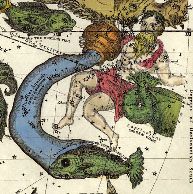
Reprinted from Meridian Magazine (Nov. 8, 2001)
©2001 by John P. Pratt. All rights Reserved.
| 1. Four Royal Stars |
| 2. Cornerstone Constellations |
| 2.1 Cherubim |
| 2.2 Tribes of Israel |
| 2.3 Balaam's Prophecy |
| 2.4 Banners and Directions |
| 2.5 Heart, Might, Mind, Strength |
| 2.6 Four Elements |
| 2.7 Four Colors |
| 2.8 Heraldry & Flags |
| 2.9 Tabernacles Colors |
| 2.10 Four Kinds of Flesh |
| 3. Roles of Christ |
| 3.1 Serpent Bearer |
| 3.2 Water Bearer |
| 3.3 The Bull |
| 3.4 The Lion |
| 4. Gospel Story |
| Notes |
Last month's article, "The Constellations Testify of Christ" was an introduction to understanding how the constellation figures revealed to the Prophet Enoch over 5,000 years ago testify of antediluvian knowledge of the coming of the Messiah, Jesus Christ. References to the constellations found in the scriptures were reviewed, as well as how the same symbolic imagery was employed by many prophets. Now let us focus on four of the most important constellations, and their four bright "royal stars."
Each of the four royal stars is in one constellation of the zodiac, which is the circle of twelve constellations around the ecliptic. Antares is located at the heart of the Scorpion (Scorpius). Fomalhaut is located at the end of the rivers of water being poured out by the Water Bearer (Aquarius). Aldebaran is located at the eye of the Bull (Taurus). Finally, Regulus is located at the heart of the Lion (Leo), which is the king of the constellations, even as the lion is called the king of beasts. These are called the four cornerstone constellations in this article because they form the corners of a great square in the sky and also provide a foundation for understanding gospel symbolism.
Two of the royal stars are listed by the ancients as being shared by two constellations. Antares is not only the heart of the scorpion, it is also the heel of the Serpent Bearer (Ophiuchus), [2] who was encircled by a great serpent (Serpens) and who is stepping on the body and head of the Scorpion. Fomalhaut is not only in the stream of the Water Bearer, it is also in the Head of the Southern Fish (Piscis Australis).[3]
In the case of the Scorpion/Serpent pair, there is a third constellation which is very closely associated with them. It is the Eagle (Aquila), which is located near the tail of the Serpent. The Eagle has been considered to typify the enemy of the serpent and is often shown holding the Serpent in its claws, even as the Serpent Bearer is crushing the Scorpion.
John the Revelator also describes four creatures, each of which is found on one side of the throne of God. One was like a lion, one like a calf, one like a man, and one like a flying eagle (Rev. 4:7). Here again we find the same four creatures which correspond to those four constellations, in this case given in the reverse order as they are found in the zodiac, which puts the leader first. The fact that these four symbols are found in a heavenly vision of the throne of God is strong corroboration of the claim in the Book of Enoch that an angel revealed the figures of the constellations to the Prophet Enoch.
2.2 Four Principal Tribes of Israel. Jacob (Israel) had twelve sons, and each of them is associated in Hebrew tradition with one of the twelve constellations of the zodiac.[4] Hebrew scholars are not sure of the correspondence of all twelve, but the identity of the four which refer to the royal constellations are clear from the scriptures. They are the four principal tribes: Reuben, Judah, Dan, and Joseph.
 |
"Judah is a lion's whelp" (Gen. 49:9) ties him to the Lion. Moreover, John refers to Christ as "the lion of the tribe of Judah" (Rev. 5:5), again linking Judah to the lion. The Lion represents the King, and Judah began the royal lineage through which the Davidic line of kings came. The name Judah means "praised," suggesting that the kings who would come through him (especially Christ) would be praised.
"Dan shall be a serpent...that biteth the horse heels" (Gen. 49:17), which parallels the symbolism of the Scorpion/Serpent, depicted stinging the Serpent Bearer in the heel. The name Dan means "judge" and the serpent symbolizes the wisdom of a judge. The serpent is acknowledged by the Lord as being one of the wisest of his creatures, probably because of its having the wise judgment of knowing when to strike. For example, the Lord has admonished his servants to be "wise as serpents and yet without sin" (D&C 111:11). The kind of wisdom referred to especially refers to that of being a good judge. Antares, the bright star in the scorpion, is located at the heart, which the Lord acknowledges as the seat of wisdom. For example, the Lord put wisdom into the heart of King Solomon so that he could judge his people wisely (2 Chron. 1:11-12, 1 Kings 10:24; compare Exodus 26:2, Ecc. 8:5, Job 38:36).
Finally, Joseph is compared to a wild ox, with the multitudes of Ephraim and Manasseh compared to its two horns (Deut. 33:17). The King James version of the Bible translates the Hebrew word for wild ox as "unicorn," as noted in the footnote of the L.D.S. edition. The Hebrew word apparently refers to an extinct species of wild ox which has two long forward pointing horns, which is exactly how Taurus is depicted. The bright star in the Bull represents its eye, which is the symbol of a seer (one who "sees"). Joseph was known as a great seer, so the Bull was especially appropriate for his sign. The name Joseph means "Jehovah has added," probably referring to his multitude of descendants. Thus, each of the four principal tribes of Israel is explicitly correlated in the blessings of Jacob to one of the four cornerstone constellations.
2.3 Balaam's Prophecy. This same imagery was repeated in the prophecy of Balaam about the destiny of Israel. He mentions that Israel "shall pour water out of his buckets" (Reuben/Water Bearer), "he lay down as a lion" (Judah/Lion), and he has "the strength of an unicorn" (Joseph/Bull), and shall "break their bones" as does either an eagle or constrictor serpent (Dan; Num. 24:7-9). The fact that again all four figures correspond to the cornerstone symbolism indicates that this prophecy likely refers to the constellations associated with these tribes.
2.4 Banners and Directions. Each of the tribes of Israel had a flag or banner with its sign. The Hebrew word for "sign" is translated "ensign" in the King James Bible (Num. 2:2), but Hebrew commentators make it clear that the signs also refer to zodiac constellations. According to tradition, the figure of a man was found on Reuben's banner, a lion on Judah's, a serpent on Dan's, and a bull on Joseph's (or more precisely, on his son Ephraim's, who took his place). When they camped, they did so with these four banners facing the four directions: Judah facing East, Reuben facing South, Ephraim facing West, and Dan facing North (Num 2:3,10,18,25).
2.5 Heart, Might, Mind and Strength. The four cornerstone constellations are also apparently symbolic of the four aspects of living souls: the emotional, spiritual, mental and physical. One example where the Lord seems to acknowledge these categories is when he tells us to serve him with all our "heart, might, mind and strength" (D&C 4:2, 59:5). The heart seems clearly to indicate emotions, the mind represents mental capacities, and strength is physical. The word "might" apparently refers to spiritual strength because the Lord sometimes says "soul" instead of might (Mark 12:30). Thus "heart, might, mind and strength" apparently refers to our emotional, spiritual, mental, and physical aspects. Note that again these four are in the same order as the four cornerstone constellations.
2.6 Elements. The Lord also uses the symbols of fire, wind, water, and earth to represent these four aspects of living creatures. For example, he stated that "ye were born into the world by water, and blood, and the spirit, and so became of dust a living soul..." (Moses 6:59). As a related example, there are two baptismal ordinances, each of which has a double significance. We are taught that the baptism of water symbolizes burial after death (Rom. 6:4), when we are immersed in the earth. Furthermore, the baptism that is associated with the ordinance of confirmation is often referred to in the scriptures as the "baptism of fire and of the Holy Ghost" (2 Nep. 31:13-17; D&C 19:31, 20:41).
2.7 Colors. These four elements are also represented by four colors. Red symbolizes the fire, blood, and emotions. White represents the spiritual, just as white clothing is used for baptisms and other sacred ordinances. Black represents the earth, and physical things in opposition to the spiritual. The water is blue (or sometimes blue-green). One example of these colors from the scriptures is the colors of the four horses in the Book of Revelation. The first four of the seven seals each have a different colored horse and also one of the four cherubim associated with them. The colors in order are white, red, black, and yellow-green (chloros in Greek, translated "pale," Rev. 6:1-8). A further indication that this symbolism refers to the constellations is that the rider of the black horse holds a balance in his hand even as the Scorpion holds the Balance (Libra) in its claws. And again, they are in the same order as the constellations, but beginning with the Bull.
One of the strong indications of these four aspects in the stars is the placement of each of the royal stars in the constellation. Regulus is located at the heart of the Lion and the color associated with Judah/East/Lion is red. The heart is considered to be the center of the emotions and red is the color of blood/fire, which was the element associated with the emotions. Thus the red lion of Judah ties to the emotions.
The ancient Greeks described Taurus as a snow-white bull. Aldebaran, the first magnitude star is located at the eye of the Bull. The eye is symbolic of a seer, as was Joseph of Egypt, who was associated with the Bull. Thus, the Bull is apparently symbolic of spiritual strength, and especially the gift of being a seer.
Fomalhaut is located in the head of the Southern Fish. This is perfect placement to represent mental powers. The color that is associated with this direction varies: it can be blue, green or even yellow. The blue and green probably represent the water, whereas the yellow has been attributed to the sunlight coming from the south (the direction associated with Reuben/Water Bearer).
Antares is located at the heart of the scorpion, whose color is black. The heart is the seat of wisdom, and the scorpion/serpent symbolizes wisdom. The heart/chest can also symbolize physical strength.
Thus, the placement of all four of the royal stars in the cornerstone constellations is consistent with the symbolism of emotional, spiritual, mental and physical aspects of all living souls. Note also that the spiritual and physical are opposite each other in the circle (white opposite black), as are the mental and emotional (blue opposite red).
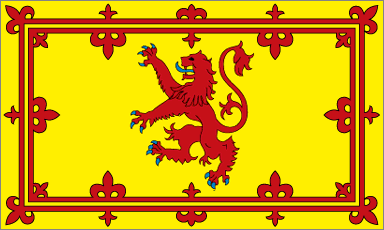 |
 |
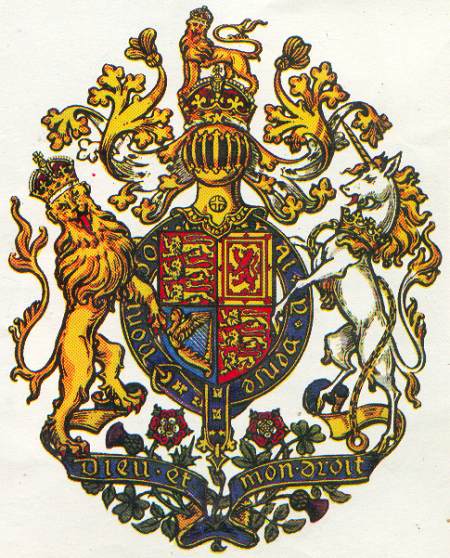 |
2.9 Four Hebrew Tabernacle Colors. The Lord commanded Moses to use four colors of cloth repeated throughout the tabernacle, especially for embroidering images of the cherubim. They were blue, purple, scarlet, and linen (white), nearly always mentioned in that order (Ex. 26:31, 36; 27:16; 28:5-15). Those are the same as the four colors of the cherubim, with purple substituted for black. That substitution could well be because purple was the color of Levi, and the tribe of Levi were the temple workers. Moreover, black is the least appropriate of the colors for a temple, which symbolizes spirituality (white). In support of this interpretation, note that in the Book of Revelation, the 144,000 temple workers include the tribe of Levi (purple), but not the tribe of Dan (black) (Rev. 7:4-8).
2.10 The Four Kinds of Flesh. The symbolism of the figures of the constellations also explain the "four kinds of flesh" as described in the scriptures. As already discussed, the Book of Revelation and Ezekiel both mention creatures having the faces of the lion, bull, man, and eagle.
When the Prophet Joseph Smith inquired to know their meaning, the Lord explained:
"They are figurative expressions, used by the Revelator, John, in describing heaven, the paradise of God, the happiness of man, and of beasts, and of creeping things, and of the fowls of the air; that which is spiritual being in the likeness of that which is temporal; and that which is temporal in the likeness of that which is spiritual; the spirit of man in the likeness of his person, as also the spirit of the beast, and every other creature which God has created." — D&C 77:2
Here the Lord mentions four kinds of creatures: man, beasts, creeping things, and birds. The Hebrew word translated as "creeping things" in the Old Testament includes reptiles, amphibians, fish,[5] and all invertebrates.
Paul also mentions four kinds of flesh: " All flesh is not the same flesh: but there is one kind of flesh of men, another flesh of beasts, another of fishes, and another of birds" (I Cor. 15:39). Here he used "fishes" to represent the "creeping things" category. The Lord gives modern day support to Paul's usage by repeating his same four categories (D&C 29:24, 101:24).
The four cornerstone constellations include representatives of each zoological category of animal by making use of double and triple constellations. First, the Scorpion, Serpent Bearer, and Eagle form a set represent invertebrates, reptiles, and birds. Second, the Water Bearer and the Southern Fish form a double constellation representing mankind and fish. The Bull represents beasts (mammals). The lion is the king of all the beasts and hence might well represent all creatures.[6]
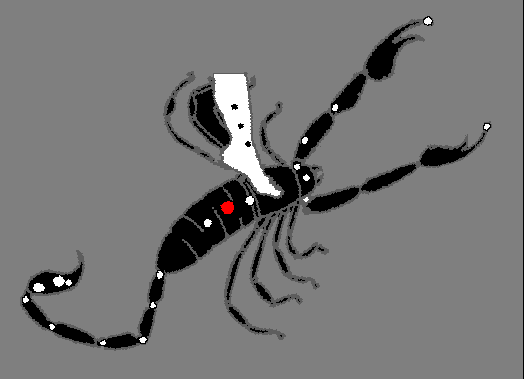 |
There are at least two important meanings which these constellations bring to mind. First, they can be seen as a graphic portrayal of the great promise that Adam and Eve heard in the Garden of Eden, when they were being judged by the Lord for having partaken of the forbidden fruit. The promise was given that someday her seed (her descendant) would have power to crush the serpent's head, even though the serpent would be able to bruise his heel (Gen. 3:15). There are several heroes in the constellations with one foot on the head of a serpent and the other foot having been wounded. For example, the Lion's feet are on the head of the Fleeing Serpent (Hydra), and Hercules' foot is firmly planted on the head of the Dragon (Draco).
 |
 |
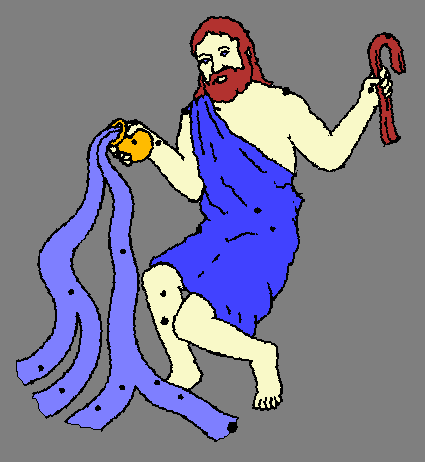 |
This is another double constellation, and the royal star is also in the head of the Southern
Fish. The fish is one symbol of Christ's Church, and one of the Savior's roles is to be the head of
his church (Eph. 5:23).
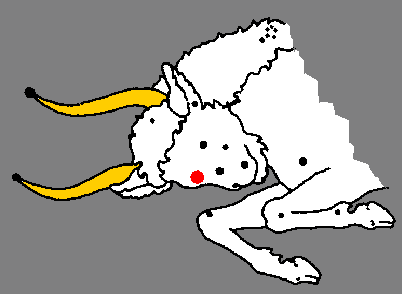 |
The bright red star in the Bull is found in its eye, representing a seer, and the Savior was the greatest prophet and seer. Even as the bull is described as being "snowy white"[8] and having a red eye, so also the savior was described as having hair "white as snow and his eyes were as a flame of fire" (Rev. 1:14).
The meaning of the wild ox seems to have been capsulized perfectly by Moses who declared that the thousands of Manasseh and the ten thousands of Ephraim are the two horns of the wild ox of Joseph, and that they would "push the people together from the ends of the earth" (Deut. 33:17, D&C 58:45), referring to the gathering of the house of Israel in the latter-days.[9] Note that the Lord used this same imagery of the thousands and also ten thousands as he introduced Moses on the day that Moses actually restored the keys of gathering Israel (D&C 110:9).
Perhaps the most interesting part for latter-day saints is that the Bull is apparently symbolic of the latter-day Kingdom of God. The prophecy of the history of the world in the Book of Enoch refers to kingdoms as animals, with the great millennial kingdom represented by a white bull:
Then I saw that a snow-white bull was born, with huge horns; all the beasts of the field and all the birds of the sky feared him and made petition to him all the time. I went on seeing until all their kindred were transformed, and became snow white cattle; and the first among them became a wild ox, and that wild ox became a great beast with huge black horns on its head. The Lord of the sheep rejoiced over it and over all the cattle. I myself [Enoch] was in their midst.
— 1 Enoch 90:37-39[10] (89:45-49 in Laurence translation).
This symbolism precisely matches that of the constellations. The white bull, the Kingdom of God in the last days, breaks into pieces the other kingdoms and grows to fill the whole earth (Dan. 2:35, 44; D&C 65:2, 105:32). "All their kindred" being transformed into snow-white cattle matches the symbolism of the twelve snow-white oxen which hold up the baptismal font in L.D.S. temples, in which all the tribes of Israel are symbolized by the bull, the symbol of the tribe of Joseph. Note also that it prophesies that Enoch himself would be with the latter-day saints, which agrees with modern revelation (Moses 7:63).
The Bull may represent Zion, the Kingdom of God in the western hemisphere, from which the law will go forth (Isa. 2:3, D&C 133:21). Moreover, because the Bull apparently represents the Kingdom of God and its great armies, another probable role of the Savior represented by the Bull is "the Lord of hosts, the God of the armies of Israel" (1 Samuel 17:45).
 |
The Lion may also represent the eastern half of the Kingdom of God in Jerusalem from which the word will go forth, even as the Bull represents the Kingdom of God in the West (Isa. 2:3). It is depicted with its forepaws near the head of the Fleeing Serpent.
The Serpent Bearer crushing the Scorpion, clearly refers to the promise that Adam and Eve heard in the Garden of Eden (Gen. 3:15). It apparently refers to when Christ was wounded by the serpent (Satan) at his Crucifixion, but the Serpent was crushed when Christ overcame death.
Next, the Water Bearer pouring living water onto the head of the Fish was begun during the Savior's mortal ministry, but more fully fulfilled after the Resurrection when Christ spent forty days teaching deeper truths to his apostles and giving them further blessings. He did likewise with the Nephites and lost ten tribes.
The third sign, the Bull, refers to the Kingdom of God in the last days which will prepare for the second coming of Christ by gathering the tribes of Israel from the four corners of the earth. It also refers to the restoration of his teachings through a great seer. It probably includes the symbolism of the Savior at his Second Coming at the beginning of the Millennium, trampling enemies underfoot.
The fourth sign, the Lion, most likely refers to the Kingdom of God in the millennium, where all things are gathered into one, and Christ rules as King of Kings. It also seems to include the final overcoming of Satan at the end of the Millennium because the Lion is crushing the head of the Fleeing Serpent. Thus, the Lion may represent the Kingdom of God finally overcoming Satan forever at the end of the Millennium in the great war at that time.
Next month we will discuss the four royal stars in more depth. As we begin to understand the depth of information contained in these constellations, we might exclaim with Enoch,
"I blessed the Lord of glory, who had made those great and splendid signs, that they might display the magnificence of his works to angels and to the souls of men; and that these might glorify all his works and operations; might see the effect of his power; might glorify the great labor of his hands; and bless him forever." — Enoch 35:3